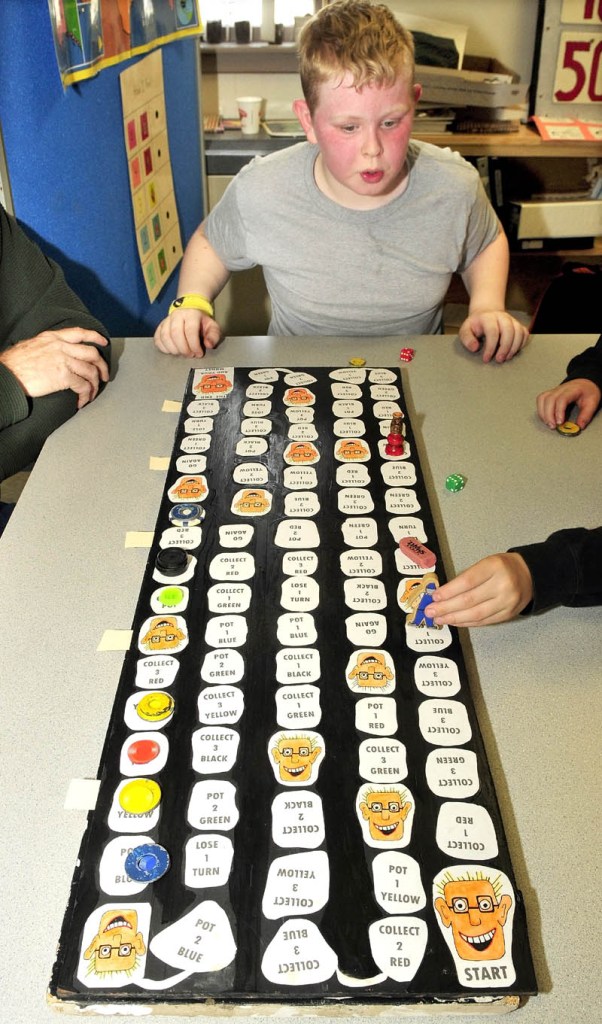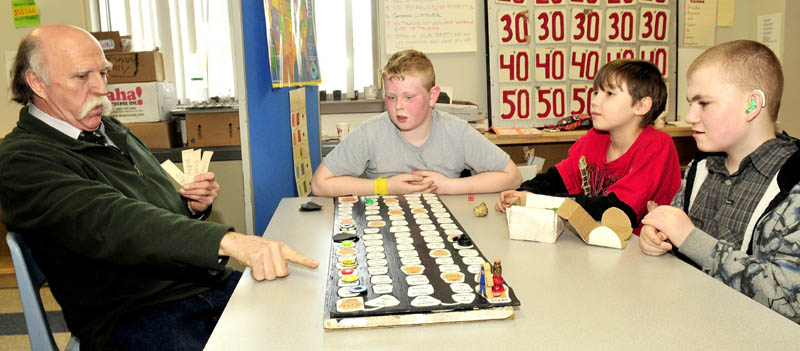FARMINGTON — Kevin McShane invents fun and educational games that his Cascade Brook School students enjoy playing.
That’s the sales pitch McShane, 64, hopes will help him raise enough money to develop one of his games to sell to other educators, parents and grandparents.
Unlike most other inventors, however, he is trying to cut out the middle man to realize his dream.
The 18-year veteran special education teacher is among the thousands of people who have found Kickstarter, the Internet fundraising platform that allows creative projects to seek startup money directly from the public.
And his journey has highlighted how the Internet is redefining the entire fundraising landscape, including how everyone from entrepreneurs to traditional charitable groups can succeed.
McShane is using the website to try to raise $8,000 to perfect his Smiling Sam the Game, a board game he invented in his New Sharon garage to help his students learn to count money.
But the website takes a unique approach to fundraising, giving people a chance to give money directly to someone with a creative project idea. People pledge to make a form of donation to support the project, which only gets the money if it meets a fundraising goal amount by a certain deadline.
McShane has a little over a month left to meet his goal, which he plans to use to produce and sell the board game. His fundraising campaign started recently and had raised $76 earlier this week.
McShane, who jokingly describes himself as just removed from the tech-savvy generation, heard about Kickstarter at a toy conference while looking for ways to get his small business venture off the ground.
He called Smiling Sam the Game a student favorite among the games he designed for his Mt. Blue Regional School District classroom in Farmington.
On Tuesday, three of McShane’s students played on the homemade wooden game board, with its smiling Sam spaces and colorful discs representing different coins. Throughout the game, they helped each other count their individual piles of coins and broke into cheers whenever they landed on smiling Sam, who reveals secrets about what colors represented which coin.
Zackary Lorom, 11, pumped his fist in the air after one lucky roll landed him on smiling Sam, adding “this is so fun.”
New take on old tradition
The idea for Kickstarter originated 10 years ago with a simple plan to help a New York City band raise enough money to perform at the New Orleans Jazz Festival, according to Justin Kazmark, spokesman for Kickstarter.
They wanted to find a way to use the Internet to pay for the trip and discovered a new take on a very old fundraising model, drawing inspiration from longstanding traditions of community-supported arts projects, he said.
In 2009, the Kickstarter website was launched to give a fundraising platform for people pursuing a variety of artistic endeavors. And it gave painters, writers and anyone involved in creative fields a way to get their projects funded directly by the community, he said.
Kazmark described Kickstarter as a value exchange, rather than a loan or investment. People provide money to support a creative project and get certain rewards directly from the artist after the work is finished, he said.
For example, donors may get a signed album from a musician or an acting role as an extra in a movie. The rewards vary based on the project, the amount donated and other factors, he said.
The projects, however, must first get approved by Kickstarter based on guidelines consisting of criteria tied to specific creative fields. Once approved, the person behind the project posts a video along with other details describing the idea on the website, he said, adding that nonprofit and charitable organizations are prohibited from applying.
Projects must also set a fundraising goal and have to reach that amount by a set deadline to move forward. A project that fails to meet the goal doesn’t get any money, which is pledged through an online credit card payment system.
A project that meets or exceeds its goal by the deadline gets funded, with the donor credit cards charged simultaneously. Kickstarter collects a 5 percent fee and the payment system provider collects a fee of between 3 and 5 percent on projects that get funded. Pledges are anywhere from $1 and up.
About $3 million per week is pledged for projects and more than $180 million has been pledged since Kickstarter launched, funding more than 20,000 successful projects, Kazmark said.
Among the most recent area Kickstarter success stories is the Maine Grains project in Skowhegan’s Somerset Grist Mill. The project raised $30,889 from 309 supporters, surpassing its goal by about $1,000 just before its deadline Thursday morning.
The money will go toward the project that is processing locally produced grains at the mill, making the site an agriculture hub for the region, according to Amber Lambke, co-owner of the mill.
In 2010, Lambke and Michael Scholz, a baker in Albion, bought the former Somerset County jail building and converted it into a grist mill. Lambke raised $1.2 million in grants and loans to renovate the building and get the project started.
She turned to Kickstarter to help finish the Maine Grains project, which faced a $350,000 funding gap despite the previous investments, she said.
“It was a great way to use the viral nature of the Internet to promote the project,” she said.
Some of the rewards for pledges included a five-pound bag of stone-milled whole wheat Maine Grain flour, a coffee table book depicting the jail renovation and original iron skeleton keys from the old jailhouse at the site.
With the successful fundraising effort, Lambke plans to get the operation going soon and encouraged others to look into starting their own Kickstarter project.
“I hope more people in Skowhegan try it and I think they can make a big difference in the community if they do,” she said.
Embracing fundraising forms
The Internet has also become a vital tool for groups that have relied for years on more traditional fundraising, forcing them to rethink how they compete for a growing pool of donors, according to Lisa Laflin, executive director of the Farmington-based United Way of the Tri-Valley Area.
Instead of primarily focusing on partnering with businesses to raise money in the workplace, a mainstay approach in past years, United Way groups have started to tap into the growing fundraising community online, she said.
“We need to grow and explore other ways of reaching out, whether that is online fundraising or targeted special events, because collectively there are a number of new and creative opportunities to give back to our community,” Laflin said.
Her United Way branch, which serves communities in Franklin County, Livermore and Livermore Falls, plans to launch an online auction in the fall, for instance, hoping to attract more bidders for donated items being sold to support the group’s cause, she said.
There is also a constant effort to better utilize the group’s website to give people more options to promote the organization and donate, with the money going to support a broad spectrum of local nonprofits each year, she said.
Laflin believes another key will be the ability to build a strong presence on social media, making it easier for people to learn about who they help by donating. Sharing a nonprofit group’s story online helps draw people who never thought about making a donation before, she said.
Laflin noted some of the plans are still just getting started, saying her group is on the cusp of doing a lot more fundraising on the Internet. But she added that traditional fundraising methods will always remain a big part of the group’s overall success.
David F. Robinson — 861-9287
drobinson@centralmaine.com
Send questions/comments to the editors.




Success. Please wait for the page to reload. If the page does not reload within 5 seconds, please refresh the page.
Enter your email and password to access comments.
Hi, to comment on stories you must . This profile is in addition to your subscription and website login.
Already have a commenting profile? .
Invalid username/password.
Please check your email to confirm and complete your registration.
Only subscribers are eligible to post comments. Please subscribe or login first for digital access. Here’s why.
Use the form below to reset your password. When you've submitted your account email, we will send an email with a reset code.